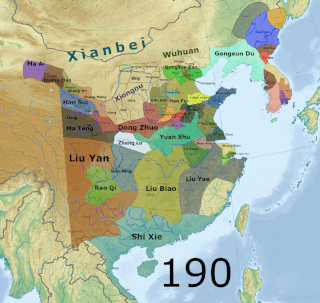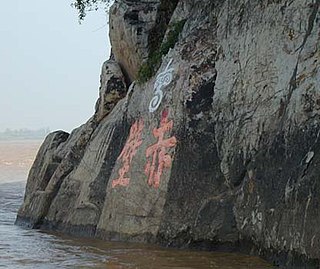
The Three Kingdoms from 220 to 280 AD was the tripartite division of China among the states of Wei, Shu, and Wu. The Three Kingdoms period started with the end of the Han dynasty and was followed by the Jin dynasty. The short-lived Yan kingdom in the Liaodong Peninsula, which lasted from 237 to 238, is sometimes considered as a "4th kingdom".

Romance of the Three Kingdoms is a 14th-century historical novel attributed to Luo Guanzhong. It is set in the turbulent years towards the end of the Han dynasty and the Three Kingdoms period in Chinese history, starting in 169 AD and ending with the reunification of the land in 280 by Western Jin. The novel is based primarily on the Records of the Three Kingdoms (三国志), written by Chen Shou.

Henan is a landlocked province of China, in the central part of the country. Henan is often referred to as Zhongyuan or Zhongzhou (中州), which literally means "central plain" or "midland", although the name is also applied to the entirety of China proper. Henan is a birthplace of Chinese civilization, with over 3,000 years of recorded history and remained China's cultural, economical and political center until approximately 1,000 years ago.

Luoyang is a city located in the confluence area of Luo River and Yellow River in the west of Henan province. Governed as a prefecture-level city, it borders the provincial capital of Zhengzhou to the east, Pingdingshan to the southeast, Nanyang to the south, Sanmenxia to the west, Jiyuan to the north, and Jiaozuo to the northeast. As of the final 2010 census, Luoyang had a population of 6,549,941 inhabitants with 1,857,003 people living in the built-up area made of the city's five urban districts, all of which except the Jili District are not urbanized yet.

Cao Cao, courtesy name Mengde, was a Chinese warlord, statesman and poet. He was the penultimate grand chancellor of the Eastern Han dynasty who rose to great power in the final years of the dynasty. As one of the central figures of the Three Kingdoms period, he laid the foundations for what was to become the state of Cao Wei and ultimately the Jin dynasty, and was posthumously honoured as "Emperor Wu of Wei" although he never was an emperor during his life time. He remains a controversial historical figure, and is often portrayed as a cruel and merciless tyrant in subsequent literature; however, he has also been praised as a brilliant ruler and military genius with unrivalled charisma who treated his subordinates like his family.

The Battle of Guandu was fought between the warlords Cao Cao and Yuan Shao in 200 CE in the late Eastern Han dynasty. Cao Cao's decisive victory against Yuan Shao's numerically superior forces marked the turning point in their war. The victory was also the point at which Cao Cao became the dominant power in northern China, leading to the establishment of the state of Cao Wei in the Three Kingdoms period.

Xu Huang, courtesy name Gongming, was a military general serving under the warlord Cao Cao in the late Eastern Han dynasty of China. He later served in the state of Cao Wei during the Three Kingdoms period under the first two rulers, Cao Pi and Cao Rui, before his death at the start of Cao Rui's reign. Xu Huang is best noted for breaking the siege at the Battle of Fancheng in 219 by routing the enemy commander Guan Yu on the field.

Yuan Shao, courtesy name Benchu (本初), was a warlord who lived in the late Eastern Han dynasty of China. He occupied the northern territories of China during the civil wars that occurred towards the end of the Han dynasty. He was also an elder half-brother of Yuan Shu, a warlord who controlled the Huai River region, though the two were not on good terms with each other.

The Battle of Red Cliffs, otherwise known as the Battle of Chibi, was a decisive naval battle in the winter of AD 208–9 at the end of the Han dynasty, about twelve years prior to the beginning of the Three Kingdoms period in Chinese history. The battle was fought between the allied forces of the southern warlords Sun Quan, Liu Bei and Liu Qi against the numerically superior forces of the northern warlord Cao Cao. Liu Bei and Sun Quan frustrated Cao Cao's effort to conquer the land south of the Yangtze River and reunite the territory of the Eastern Han dynasty.
Bao Xin (152–192) was a military general and minor warlord who lived during the late Eastern Han dynasty of China.

The end of the Han dynasty refers to the period of Chinese history from 189 to 220 AD, which roughly coincides with the tumultuous reign of the Han dynasty's last ruler, Emperor Xian. During this period, the country was thrown into turmoil by the Yellow Turban Rebellion (184–205). Meanwhile, the Han Empire's institutions were destroyed by the warlord Dong Zhuo, and fractured into regional regimes ruled by various warlords, some of whom were nobles and officials of the Han imperial court. Eventually, one of those warlords, Cao Cao, was able to gradually reunify the empire, ostensibly under Emperor Xian's rule, but the empire was actually controlled by Cao Cao himself.

Ju Shou was an adviser serving under the warlord Yuan Shao during the late Eastern Han dynasty of China.
Zhu Ling , courtesy name Wenbo, was a military general of the state of Cao Wei during the Three Kingdoms period of China. He previously served under the warlords Yuan Shao and then Cao Cao during the late Eastern Han dynasty.

The Campaign against Dong Zhuo was a punitive expedition initiated by a coalition of regional officials and warlords against the warlord Dong Zhuo in 190 in the late Eastern Han dynasty. The members of the coalition claimed that Dong had the intention of usurping the throne by holding Emperor Xian hostage and by establishing a strong influence in the imperial court. They justified their campaign as to remove Dong from power. The campaign led to the evacuation of the capital Luoyang and the shifting of the imperial court to Chang'an. It was a prelude to the end of the Han dynasty and, subsequently, the Three Kingdoms period.

Tongguan or Tong Pass, was a former mountain pass and fortress located south of the confluence of the Wei and Yellow Rivers, in today's Tongguan County, Shaanxi, China. It was an important chokepoint, protecting Xi'an and the surrounding Guanzhong region from the North China Plain. Tong Pass was built in 196 AD by the warlord Cao Cao during the late Han dynasty. The fortress was the seat of Tongguan County, but was demolished in the 1950s to make way for the Sanmenxia Dam and reservoir.
The Battle of Xingyang was a battle fought in 190 in the late Eastern Han dynasty as part of the campaign against Dong Zhuo. It took place when Dong Zhuo's retreating forces, led by Xu Rong, encountered Cao Cao's pursuing army at Xingyang.
The Battle of Boma or Battle of Baima was the first of a series of battles that led to the decisive Battle of Guandu between the warlords Yuan Shao and Cao Cao in northern China in the late Eastern Han dynasty of China. Although Cao Cao won the battle and Yuan Shao lost his elite general Yan Liang, Cao eventually abandoned his position in Boma to entrench at the strategically important Guandu.
The Battle of Yan Ford took place along the southern banks of the Yellow River in the late Eastern Han dynasty. The battle was closely preceded by the Battle of Boma, and was part of a series of engagements leading to the decisive confrontation between the rival warlords Yuan Shao and Cao Cao at the Battle of Guandu in 200. Following the death of one of Yuan Shao's elite generals, Yan Liang, in the previous battle, the death of another famed general Wen Chou in this battle greatly demoralised Yuan's army, which was heading towards Guandu.
Du Ji, courtesy name Bohou, was an official who lived in the late Eastern Han dynasty of China. He later served as a high-ranking official in the state of Cao Wei during the Three Kingdoms period. He had the reputation of being a model governor, valiant, loyal and wise. He was the grandfather of Du Yu, the author of the most influential Zuo Zhuan commentary, who gave the work its modern form.














